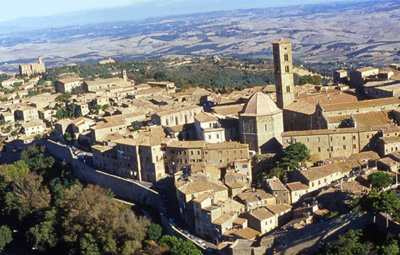
VOLTERRA
Volterra is an Etruscan city of great architectural interest. Built on a high plateau, 1770 feet above sea level between the Rivers of Bra and Cecina, there are spectacular views of the surrounding hills. Enclosed by yellowy-gray volcanic hills, it has a bleak and isolated appearance. In the Etruscan period, Volterra, called Felathri by the Etruscans and Voltarrae by the Romans was one of the most important cities in the Etruscan Confederation. From the period of the kings, it was at war with Rome. Remains of the ancient surrounding walls, including the Etruscan Porta dell’ Arco, may still be seen today. Also surviving are ruins of the baths, an aqueduct, an amphitheatre, and Etruscan burial places. The city is famous for its craftsmen who carve statues out of the locally mined alabaster.
Palazzo dei Priori, the medieval seat of the government on the Piazza dei Priori, is the oldest of its kind in Tuscany probably inspired the design for the Palazzo Vecchio in Florence It is in the heart of Volterra, enclosed by an almost totally medieval group of buildings. Built between 1208 and 1257, it is still used for town council meetings. It is situated on the medieval rectangular Piazza dei Priori. It was a market place as early as 851.
Baptistry was erected on an octagonal base that has been dated as 13th century. The façade is adorned with stripes of white and green marble and the main entrance is surmounted by an architrave decorated with the sculptured heads of Christ, the Virgin and the apostles, a work of an artist close to Nicola Pisano. It is said that Brunelleschi offered advice for the construction of the dome in the 15th century.
Duomo has a Romanesque façade and is interposed by the geometric intarsia marble framework of the main entrance added in the 13th century and attributed by Vasari to Nicola Pisano. The entrance is through the baptistry, as you couldn’t enter until you were baptized. One of the most spectacular sights is the 1580 ceiling that is carved and embossed in gold and azure and is filled with portraits of Volterran saints.
Guarnacci Museo is one of Italy’s major archeological museums and one of the earliest public museums in Europe. It consists entirely of local finds, including some 600 Etruscan funerary urns. Carved in alabaster, terracotta or local sandstone or limestone, they date from the fourth to first centuries BC.
Alabaster Workshops in the historical center today are few, but those which remain have been entrusted with the preservation of this ancient tradition and the creative evolution of the craft. Volterra’s alabaster is of the chalky variety ( hydrated calcium sulphate) and was formed during the Miocene period as the sediments of calcium sulphate contained in the sea water underwent a process of concentration. A soft white stone, alabaster is more easily carved than marble. Once the stone of the gods, the Etruscans were the first to carve alabaster for their cinerary urns. The Etruscans chose the highest quality pure alabaster which they painted with minerals and sometimes decorated with a very thin layer of gold. Very few artifacts from the Medieval and Renaissance periods have been found which suggests that alabaster was seldom carved during that era. The alabaster craft was reestablished in the 17th century and flourished at the beginning of the 18th century as skilled artisans and sculptors launched the reproduction of classical art and high quality artifacts renowned throughout the world.
In 1780 the Grand Duchy of Tuscany registered 8 or 9 artisan workshops in Volterra. By 1830 the number had risen to more than 60 thanks to the innovative spirit of the “traveling craftsmen” who traveled the world selling their wares, opening shops, taking part in fairs and auctions. Until 1870 the alabaster craft flourished and harvested an excellent repute in Italy and abroad. In spite of long intervals of regression, the alabaster industry has continued to conserve the age-old tradition of the craft.
Teatro Romano is situated just outside the city walls. It is an ancient Roman theatre dating from 5 to 20 AD. The monument was built at the end of the first century BC
www.volterratur.it
